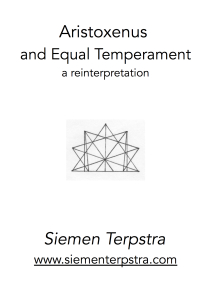I  was repeatedly told that one cannot set a tempered harmony on a monochord by classical means. However, I realised that one exception exists, the complex of multiple divisions 12-et, 24-et, 36-et, 72-et, and 144-et. These very systems are the ones clearly described by Aristoxenus. This realisation prompted the following study of Aristoxenus.
was repeatedly told that one cannot set a tempered harmony on a monochord by classical means. However, I realised that one exception exists, the complex of multiple divisions 12-et, 24-et, 36-et, 72-et, and 144-et. These very systems are the ones clearly described by Aristoxenus. This realisation prompted the following study of Aristoxenus.
I wrote this paper very long ago. I still stand by most of it, but a couple of my conjectures have shifted over the years. In the paper I presumed that Pythagoreans did much of the research into irrational ratios. In spite of the example of Hippasus, I now feel that the Pythagoreans were generally conservatives and the bulwark of anti-temperament sentiment. Work on irrationals was likely done by anti-pythagorean elements, such as Democritus.
Also, I conjecture that Philolaus the Pythagorean supports 53-et. Now I no longer believe that to be the case. My argument there was simple enough. Since he knew that the 8:9 whole tone is nine commas in size, he must have known that the ditone equals eighteen commas, the fourth twenty-two and the octave fifty-three. He may well have thought that his commas were all the same size, when they were likely not to be so. I now think that Philolaus probably abhorred the very idea of temperament.
For my current thinking on this topic, see my recent essay HOMAGE TO PTOLEMY (a companion paper to ARISTOXENUS) under the heading MONOCHORD. See also RESTORING THE MUSE under the philosophy heading.
Click on the links to see the article in your browser or right-click to save the files to your drive.
http://siementerpstra.com/writings/Terpstra-Aristoxenus.pdf
http://siementerpstra.com/writings/Terpstra-AristoxenusDiagrams.pdf